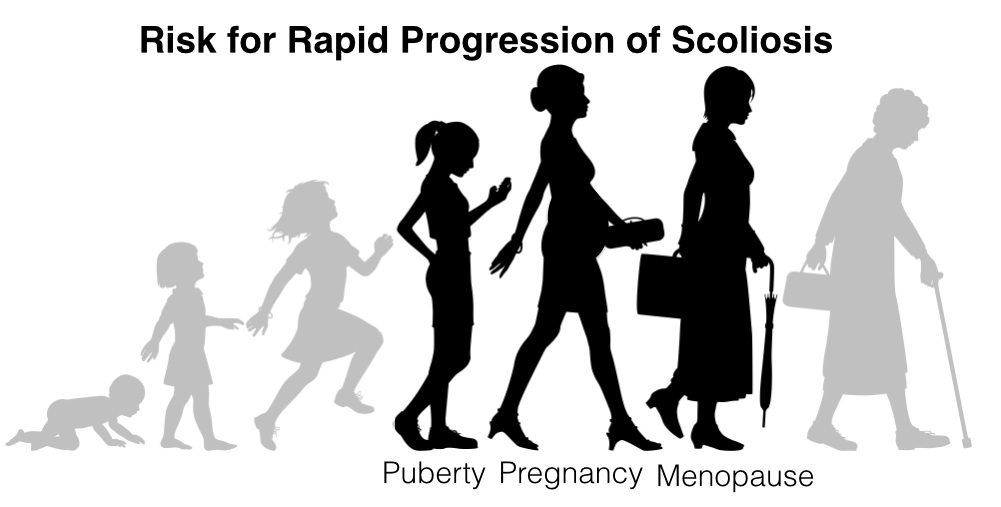What Can Cause Your Scoliosis To Progressive Rapidly?
While most orthopedist consider that once a child stops growing the risk for progression of their scoliosis goes away, the fact is that this is only partially true. While the risk for rapid progression diminishes greatly at skeletal maturity, it is not the only time in life that scoliosis can progress. In fact, for a woman with scoliosis there are 3 times in her life that she risks rapid progression of her scoliosis curves, if she’s not doing anything to stabilize her spine.
3 Times of Life A Woman’s At Risk For Scoliosis Progression

- Puberty – Rapid Growth & Hormonal Changes
- Pregnancy – Hormone Relaxin Relaxes Ligaments
- Menopause – Bony Changes
Additional Risk for Slow Progression of Scoliosis
In addition to the risk for rapid progression scoliosis research shows that once a curve reaches a certain tipping point (generally considered around 30°) gravity really starts to takes advantage of the imbalanced spine. Gravitational pull can cause a slow progression of about 1° per year. At that rate it would mean a 14 year old girl with a 30° curve, if she did nothing to help stabilize her spine, could end up with a 50° curve by the time she is 34 years old.
Keys to Scoliosis Correction & Stability
- Moving the Body More Towards the Mid-Line – Reduces imbalanced gravitational forces
- Strengthen Specifically Weakened Muscles in the Spine and Trunk – Relieves muscle strain to the other side
- Improve Patterns of Movement and Postural Awareness – Keeping your spine from collapsing into the downward spiral of scoliosis
Coming Up Next…
In the next installment of this scoliosis educational series we will discuss how stabilization of the spine can be achieved and what types of treatment for scoliosis are most successful in helping the body retain these changes that can help you reduce your curves and stabilize your spine.

I am in my late 50s and am experiencing Menopausal problems with my spine. I am having issues with sciatic pain in my lower back and rt. leg. What can I do to help me without taking harmful drugs or any more surgery?
Sharon, As you read it’s not unusual for scoliosis to progress rapidly surrounding the onset of menopause. If this is the case with you and it is the collapse of your scoliosis that is causing your back and right leg pain then we can likely help you. Please give us a call at (800) 943-1254 for a Free Phone Consult to discuss your case further. Dr. Brett Diaz, D.C.
I am 24 years old and have 1 kid..i was 18 yr old when i was diagnosed with mild scoliosis..before my humps in my back is not noticeable but right after my pregnancy it became prominent…and my back pain is getting worst..i dont receive any treatment..can i wear braces eventhough my bones are fully matured now?
The answer is most definitely “yes”. About half or our patients are adults with with scoliosis and although they are done growing we can help them improve their scoliosis with the SpineCor brace and Schroth Method. If you are interested in finding out if these treatments are right for you then give us a call at (800) 943-1254 for a Free Phone Consult.
my father is 80 yr old and has developed lumbo scoliosis of right side, any non surgical treatment for him. He is not on any medication for this problem except for some calcium tablets
my son has a severe kyphosis and scoliosis he has had it since he was three months old, He is very crooked and twisted his mobility is hampered greatly and his breathing. He is only 18 years old but it’s not getting any better with time.
The SpineCor brace has set-ups for both Scoliosis and hyper-kyphosis so chances are we could help him with both. http://scoliosistreatmentalternatives.com/3802/treatment-for-kyphosis/ Please give us a call at (800) 943-1254 and the staff can schedule you a Free Phone Consultation to speak with one of our doctors about your son’s kyphoscoliosis to see if our treatment programs are right for him.
My son has severe kyphosis and scoliosis since he was three months old. The scoliosis started when he was around eight years old it has gotten to the point where he can feel his spine touching his neck. He has little movement in his neck and he is smaller then anyone his age that is typical. He is now 18 and though he feels little pain and some discomfort he suffers from sleep apnea. We have never opted for surgery because we knew that it wasn’t the answer for him.
Donna, It’s not unusual for adolescent to have little or no pain related to their scoliosis or kyphosis but if your son’s kyphosis is severe then it’s likely only a matter of time before he develops pain due to the deterioration of his spine. It’s far better that he deal with it now, before it gets any worse as the greater the curve gets, the greater it is to correct.